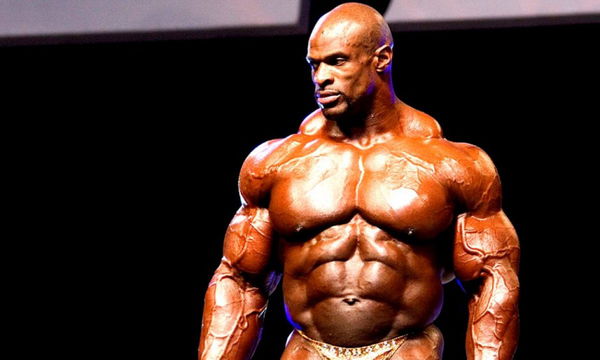

Bubble gut, HGH gut, and Palumboism. The distended gut is one of the most peculiar phenomenons in modern bodybuilding. While the midsection is often the slimmest part of a bodybuilder’s upper body, for a while even elite bodybuilders walked around on stage with blown-out midsections. Despite sporting six-pack abs and rock-hard conditioning, their midsections protruded.
Watch What’s Trending Now!
Pro bodybuilder Dave Palumbo was among the first offenders, competing with a disproportionately massive gut during the twilight of his career. In fact, the term Palumboism was derived from the bodybuilder’s last name. While the phenomenon was becoming more common in the early and mid-2010s, it has since disappeared from elite competitions. Now, even near 300-pound bodybuilders hit vacuums on the Olympia stage. So when did bubble guts become a thing and what was the cause? The answer isn’t clear.
ADVERTISEMENT
When did the bubble gut appear in bodybuilding?
The bubble gut first appeared during the mass monster era. In 1992, Dorian Yates became Mr. Olympia and set a benchmark for how big a bodybuilder could get. In subsequent years, Yates pushed the envelope further, reaching 309 lbs during the off-season. Those who wanted to defeat Yates followed suit and thus began the mass monster era in bodybuilding.

ADVERTISEMENT
Gone were the aesthetic, proportionate, yet less conditioned physiques of the golden era. Yates made it all about maximum muscle mass and conditioning. After Yates, Ronnie Coleman took things even further, competing on stage with a mindboggling 300 lbs of pure muscle. This is when bodybuilding audiences first saw what a bubble gut was.
ADVERTISEMENT
During the mass monster era, bodybuilders relentlessly chased size. They also had access to more and newer performance-enhancing drugs than ever before. So not only did their diets get more extreme, but so did their ste***d protocols. During his bodybuilding prime, Ronnie Coleman consumed 6000 calories a day to maintain his size. The bubble gut might be a combination of all those factors.
Top Stories
Everything You Need to Know About Mr. Olympia’s Sole Owner Jake Wood, Who Also Brought Ms. Olympia Back

Why Tadalafil Is Used in Bodybuilding: Is It Actually Safe and Effective?

“My Arm Is Not Coming Back”: Despite a Paralyzed Arm, a 19-Y.O. Sculpts an Unbelievable Physique After Coming Out of Coma

Top Natural Bodybuilders: The Best of the Best in the Fitness World

“People Shrink With Age”: Despite Being 6’2, Arnold Schwarzenegger’s Height Next to 7X Mr. Olympia Becomes the Talk of the Bodybuilding World

The two prime suspects behind the bubble gut
Today, many experts believe that two performance-enhancing drugs, HGH and insulin, cause the bubble gut. The Human Growth Hormone became popular in bodybuilding during the mass monster era and continues to remain popular to this day. Bodybuilders who speak openly about PED use in the sport say that most competitors use HGH to gain muscle mass.
ADVERTISEMENT
The hormone helps the body put on more muscle. However, many believe that it doesn’t discriminate when used in high enough doses for bodybuilding. When someone uses a lot of HGH it might lead to organomegaly. Dr. George Touliatos explained that the hormone causes abnormal enlargement of the organs, and they push against the abdominal wall.
Since the abdominal wall isn’t surrounded by the rib cage, the gut protrudes through it. While bodybuilders might have strong cores, it’s not enough to withstand the pressure of the enlarged organs, leading to the bubble gut. However, Touliatos also explained that HGH cannot alone may not lead to the bubble gut.
ADVERTISEMENT
During an exclusive interview with Generation Iron, George Touliatos, aka Dr. Testosterone said overuse of insulin aids in causing the HGH gut. The former bodybuilding champion said too much insulin without a proper diet leads to visceral fat buildup. Visceral fat surrounds the organs in the abdominal region. Meanwhile, organomegaly from HGH only makes things worse. However, another theory discounts organomegaly as the cause of the bubble gut.
Was it just about overeating?
Renowned science-based fitness YouTuber Derek from More Plate More Dates explained that overeating might be the real cause of the bubble gut. The influencer explained that despite the overuse of HGH in bodybuilding, organomegaly doesn’t contribute to the bubble gut. Instead, he blames it on the extreme diet of the bodybuilders from the mass monster era.
ADVERTISEMENT

ADVERTISEMENT
The YouTuber argued that bodybuilders started eating so much that they developed insulin resistance. Overconsumption of carbs to get bigger leads to insulin resistance and increased blood sugar levels. HGH also raises blood sugar levels further, and “pre-diabetic” symptoms start to set in. “Intestinal transit is severely impaired,” and leads to bloating and a distended gut, said Derek.
While this is Derek’s theory, he also showed some proof. The bodybuilder explained many bodybuilding icons like Phil Heath and Roelly Winklaar have reversed their bubble gut. On the other hand, If HGH enlarged their organs, they would have had to live with the condition as it is impossible to shrink enlarged organs.
ADVERTISEMENT
The reason that a definitive answer to bubble gut hasn’t been found is due to the lack of research. Most modern bodybuilders do suffer from the bubble gut, and no studies were performed on those who did suffer from it in the past. Hence, for now, bubble gut in bodybuilding remains a peculiar phenomenon, with only theories as answers.
ADVERTISEMENT
ADVERTISEMENT
ADVERTISEMENT

